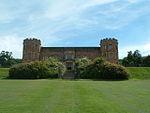Maker, Cornwall

Maker (Cornish: Magor) is a village between Cawsand and Rame Head, Rame Peninsula, Cornwall, England, United Kingdom. The name means a ruin or old wall in Cornish, possibly because the church was built from the ruins of West Stonehouse in Cremyll. This origin of the name is unlikely, as Maker is first referred to in 705AD, which predates the construction of the church. Another supposition, is that the "old walls" are those of a (now lost) Roman-British villa. However, another Celtic name is Egloshayle, (not to be confused with Egloshayle on the River Camel) which means, "the church on the estuary".The village and its neighbour Rame are in the civil parish of Maker with Rame and the parliamentary constituency of South East Cornwall. The parish had a population of 1,020 at the 2011 census.
Excerpt from the Wikipedia article Maker, Cornwall (License: CC BY-SA 3.0, Authors, Images).Maker, Cornwall
Geographical coordinates (GPS) Address Nearby Places Show on map
Geographical coordinates (GPS)
| Latitude | Longitude |
|---|---|
| N 50.3451 ° | E -4.1911 ° |
Address
PL10 1JB , Maker-with-Rame
England, United Kingdom
Open on Google Maps









